Have you ever wondered how makeup is made? The process of creating cosmetics involves a fascinating journey from sourcing raw materials to formulating and manufacturing the final product. In this article, we’ll delve into the various ingredients used in eyeshadow, foundation, and lip gloss, the process of mixing and formulating, and more.
The Ingredients in Makeup
1. Eyeshadow
The basic ingredients in eyeshadow are mica, binders, preservatives, and pigments. Mica is a naturally occurring mineral dust often used in makeup products because of its glittering or shimmering properties. Binders, such as Magnesium Stearate, keep the powder eyeshadow together so it won’t crumble. Preservatives are used to extend the shelf life, and pigments give the eyeshadow its color.
Eyeshadow may also contain fillers like talc or kaolin clay to reduce the intensity of the pigments.
2. Foundation
The main components of foundation include water, emollients, pigments, and preservatives. Water forms the base of liquid foundation, while emollients like oils and waxes provide a smooth application and give the skin a soft appearance.
Pigments give the foundation its color and can be customized to match a broad spectrum of skin tones. Some foundations also contain SPF ingredients to provide sun protection. Modern foundations often include beneficial extras such as vitamins, minerals, and antioxidants for added skincare benefits.
3. Lip Gloss
The major components of lip gloss are oils (like lanolin or jojoba oil), emollients, and waxes. These ingredients give the lip gloss its characteristic smooth, glossy appearance. Some lip glosses also contain tiny particles of mica for a shimmery effect. Flavorings, colorants, and preservatives are added to provide variety and extend shelf life.
The Process of Mixing and Formulating Makeup
The process of making makeup often starts with the creation of a base. For instance, in the case of eyeshadow, this base often includes the binder and filler. Then, color pigments are added gradually and mixed thoroughly until the desired shade is achieved.
The ingredients for liquid makeup, like foundation and lip gloss, are often mixed together in a specific order to ensure a uniform consistency. For example, in foundation, the pigment is often mixed with a small amount of oil to form a smooth paste, and then the remaining ingredients are gradually incorporated.
The mixtures then go through a milling process to ensure all the ingredients are evenly distributed and to give the product a smooth texture. For powder products like eyeshadow, the milled mixture is then pressed into pans. For liquid products, the mixture is usually poured into its final packaging while still in a liquid state.
Quality control tests are then conducted on the final product. These tests may include microbial testing to ensure the preservatives are effective, stability testing to see how the product performs over time, and compatibility testing to check the product’s reaction to its packaging.
Common Ingredients Used in Makeup
Mica: A mineral dust that provides shimmer and glitter. Generally considered safe, although ethical sourcing can be an issue due to labor concerns in the mining process. There are no specific regulations related to mica in cosmetics.
Talc: A soft mineral used as a filler to reduce pigment intensity. Generally considered safe, but has been controversial due to concerns about contamination with asbestos, a known carcinogen. Cosmetic-grade talc is regulated and should be free from asbestos.
Titanium Dioxide: Used as a white pigment and in sunscreen. Considered safe for use in cosmetics, but should not be inhaled, so it should be used carefully in powder form.
Zinc Oxide: A white pigment used for color and in sunscreen. Considered safe for use in cosmetics, with anti-inflammatory properties especially beneficial for sensitive skin types.
Iron Oxides: These are pigments used to provide color. They are considered safe for use in cosmetics.
Parabens (Methylparaben, Propylparaben, etc.): These are preservatives used to prevent the growth of bacteria and mold. There’s been some controversy over their safety, as some studies have suggested they may disrupt hormones. As of my knowledge cutoff in September 2021, the FDA considers them safe at current levels used in cosmetics, but research is ongoing.
Silicones (Dimethicone, Cyclomethicone, etc.): These give products a smooth application and a pleasing texture. They are considered safe as used in cosmetics, although they’ve been critiqued from an environmental perspective, as they are not biodegradable.
Fragrance: This can refer to thousands of ingredients used to scent products. Some people are allergic to certain fragrances. Due to trade secret laws, companies are not required to disclose what exactly their “fragrance” consists of, which has led to calls for greater transparency in labeling.
Lead: This is a heavy metal that can sometimes contaminate cosmetics, particularly color cosmetics like lipstick. Exposure to lead is a health concern, and the FDA provides guidance to manufacturers to avoid lead contamination.
Mineral Oil: Used for its moisturizing properties. It’s considered safe for topical use, but there have been concerns about potential contamination with harmful substances.
It’s crucial to remember that “natural” does not always mean “safe,” and “synthetic” does not always mean “unsafe.” Every ingredient, natural or synthetic, has the potential to cause an adverse reaction depending on individual sensitivities, usage, and concentration.
Harmful Makeup Ingredients
Regulations related to cosmetics vary by country. In the U.S., the Food and Drug Administration (FDA) oversees cosmetics under the Federal Food, Drug, and Cosmetic Act. The European Union also has its regulatory framework for cosmetic products, often considered more stringent than U.S. regulations. They maintain a database called CosIng for information on cosmetic substances and ingredients.
Here are a few ingredients that are controversial and may be better to avoid if possible:
- Parabens (Methylparaben, Propylparaben, etc.)
- Phthalates
- Lead and Other Heavy Metals
- Formaldehyde and Formaldehyde-Releasing Preservatives
- Triclosan
- Oxybenzone
- PEG Compounds (Polyethylene Glycols)
It may be worth seeking products that avoid these ingredients especially if you have specific health concerns or allergies.
Last words
At Leecosmetic, we understand the potential concerns surrounding the use of certain ingredients in cosmetics. As such, customers can rely on us to provide clear and comprehensive ingredient lists.
Certificated with ISO, GMPC, FDA, and SGS certification, we are committed to formulating our products with the utmost attention to safety standards, ensuring the exclusion of controversial substances.

